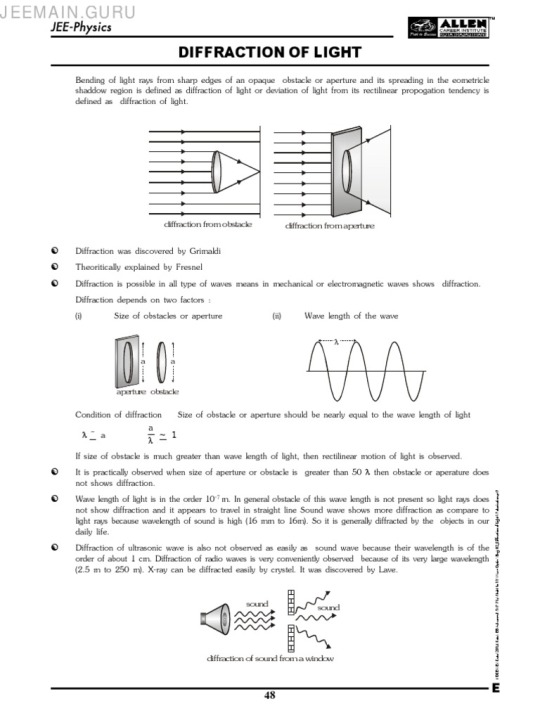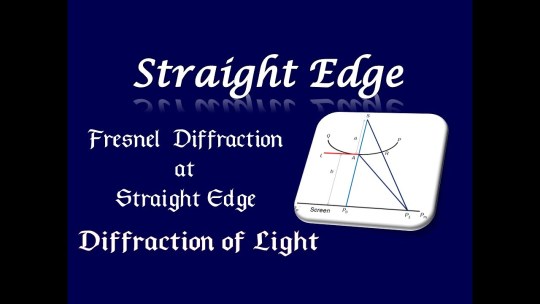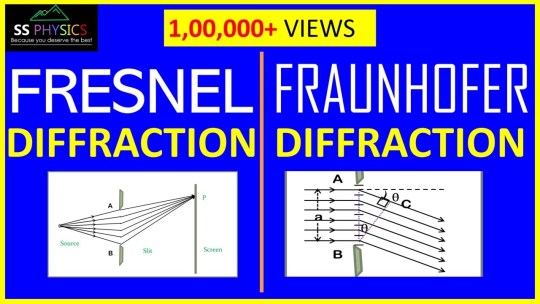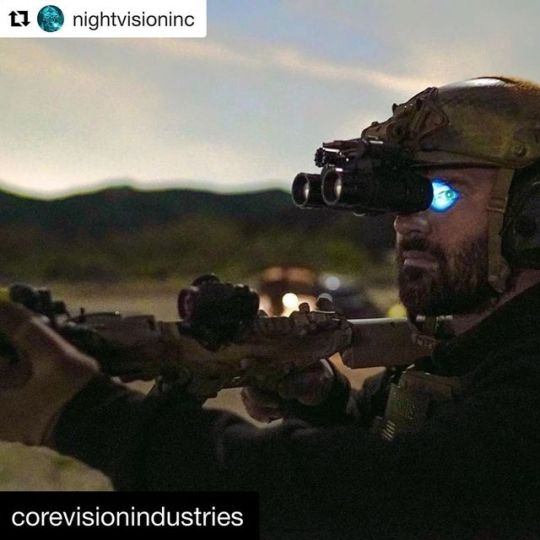#greenphosphor
Explore tagged Tumblr posts
Text
Fresnel Diffraction Of Light

Fresnel's diffraction: It means that source of light and screen at finite distance from the obstacle. In this case no lenses are used for making rays parallel. The wavefront is either spherical or cylindrical. Types of diffraction (a) Fresnel: In which source and screen are at finite distance wavefronts are curved. Fresenl’s diffraction: (b) Fraunhofer: In which source and screen are effectively at infinite distances i.e. Wave fronts are plane. Fraunhofer’s diffraction: 3. Fresnel’s half period zones.
Fresnel Diffraction Equation
Fresnel Diffraction Simulation
Fresnel Diffraction Of Light Equation
Article
Theories of light through history
Geometrical optics: light as rays
Light as a wave
Interference
Diffraction effects
Light as electromagnetic radiation
Electromagnetic waves and the electromagnetic spectrum
The speed of light
Polarization
Energy transport
Quantum theory of light
Principal historical developments
Quantum mechanics
Emission and absorption processes

In fresnel diffraction, either the source of light or the screen or both are at finite distances from the obstacle causing diffraction. Here to get the diffraction effect on the screen, no modification is made by lenses and mirrors. Example: Diffraction at a single slit.
Mar 10, 2018 On March 10, 1788, French civil engineer and physicist Augustin-Jean Fresnel was born. Augustin-Jean Fresnel ‘s research in optics led to the almost unanimous acceptance of the wave theory of light, excluding any remnant of Newton ‘s corpuscular theory, from the late 1830s until the end of the 19th century. Line drawing. Now we want to calculate the irradiance of the Fresnel diffraction of a circular aperture at off-axis positions. 4 shows the schematic setup. Source Aperture Observation Plane x y ξ η z1 z 2 Fig. Fresnel diffraction of circular aperture. The general equation for the amplitude of the Fresnel diffraction pattern is given by (8) u@ x,yD.
Poisson’s spot
Fresnel presented much of his work on diffraction as an entry to a competition on the subject sponsored by the French Academy of Sciences. The committee of judges included a number of prominent advocates of Newton’s corpuscular model of light, one of whom, Siméon-Denis Poisson, pointed out that Fresnel’s model predicted a seemingly absurd result: If a parallel beam of light falls on a small spherical obstacle, there will be a bright spot at the centre of the circular shadow—a spot nearly as bright as if the obstacle were not there at all. An experiment was subsequently performed by the French physicist François Arago, and Poisson’s spot was seen, vindicating Fresnel.
Circular apertures and image resolution
Circular apertures also produce diffraction patterns. When a parallel beam of light passes through a converging lens, the rules of geometrical optics predict that the light comes to a tight focus behind the lens, forming a point image. In reality, the pattern in the lens’s image plane is complicated by diffraction effects. The lens, considered as a circular aperture with diameter D, produces a two-dimensional diffraction pattern with a central intensity maximum of angular width about λ/D. Angular width refers to the angle, measured in radians, that is defined by the two intensity minima on either side of the central maximum.
Fresnel Diffraction Equation

Diffraction effects from circular apertures have an important practical consequence: the intensity patterns in optical images produced by circular lenses and mirrors are limited in their ability to resolve closely spaced features. Each point in the object is imaged into a diffraction pattern of finite width, and the final image is a sum of individual diffraction patterns. Baron Rayleigh, a leading figure of late 19th-century physics, showed that the images of two point sources are resolvable only if their angular separation, relative to an imaging element of diameter D, is greater than about 1.2λ/D (“Rayleigh’s criterion”).

Circular aperture diffraction effects limit the resolving power of telescopes and microscopes. This is one of the reasons why the best astronomical telescopes have large-diameter mirrors; in addition to the obvious advantage of an increased light-gathering capability, larger mirrors decrease the resolvable angular separation of astronomical objects. To minimize diffraction effects, optical microscopes are sometimes designed to use ultraviolet light rather than longer-wavelength visible light. Nevertheless, diffraction is often the limiting factor in the ability of a microscope to resolve the fine details of objects.

Fresnel Diffraction Simulation
The late 19th-century French painter Georges Seurat created a new technique, known as pointillism, based on diffraction effects. His paintings consist of thousands of closely spaced small dots of colour. When viewed up close, the individual points of colour are apparent to the eye. Viewed from afar, the individual points cannot be resolved because of the diffraction of the images produced by the lens of the eye. The overlapping images on the retina combine to produce colours other than those used in the individual dots of paint. The same physics underlies the use of closely spaced arrays of red, blue, and greenphosphors on television screens and computer monitors; diffraction effects in the eye mix the three primary colours to produce a wide range of hues.

Atmospheric diffraction effects
Diffraction is also responsible for certain optical effects in Earth’satmosphere. A set of concentric coloured rings, known as an atmospheric corona, often overlapping to produce a single diffuse whitish ring, is sometimes observed around the Moon. The corona is produced as light reflected from the Moon diffracts through water droplets or ice crystals in Earth’s upper atmosphere. When the droplets are of uniform diameter, the different colours are clearly distinct in the diffraction pattern. A related and beautiful atmospheric phenomenon is the glory. Seen in backscattered light from water droplets, commonly forming a fog or mist, the glory is a set of rings of coloured light surrounding the shadow of the observer. The rings of light, with angular diameters of a few degrees, are created by the interplay of refraction, reflection, and diffraction in the water droplets. The glory, once a phenomenon rarely observed, is now frequently seen by airline travelers as coloured rings surrounding their airplane’s shadow on a nearby cloud. Finally, as pointed out in the section Dispersion, the primary and secondary arcs of a rainbow are adequately explained by geometrical optics. However, the more subtle supernumerary bows—weak arcs of light occasionally seen below the primary arc of colours—are caused by diffraction effects in the water droplets that form the rainbow.
Doppler effect
Fresnel Diffraction Of Light Equation
https://foxstocks140.tumblr.com/post/653828009395109888/lastpass-popup-login. In 1842 Austrian physicist Christian Doppler established that the apparent frequency of sound waves from an approaching source is greater than the frequency emitted by the source and that the apparent frequency of a receding source is lower. The Doppler effect, which is easily noticed with approaching or receding police sirens, also applies to light waves. The light from an approaching source is shifted up in frequency, or blueshifted, while light from a receding source is shifted down in frequency, or redshifted. The frequency shift depends on the velocity of the source relative to the observer; for velocities much less than the speed of light, the shift is proportional to the velocity.
The observation of Doppler shifts in atomic spectral lines is a powerful tool to measure relative motion in astronomy. Most notably, redshifted light from distant galaxies is the primary evidence for the general expansion of the universe. There are a host of other astronomical applications, including the determination of binary star orbits and the rotation rates of galaxies. The most common terrestrial application of the Doppler effect occurs in radar systems. Electromagnetic waves reflected from a moving object undergo Doppler shifts that can then be used to determine the object’s speed. In these applications, ranging from monitoring automobile speeds to monitoring wind speeds in the atmosphere, radio waves or microwaves are used instead of visible light.

0 notes
Video
First appearance of #greenphosphor #hulk pulling the #airplane forward WOW
0 notes
Photo

#Repost @nightvisioninc with @get_repost ・・・ So happy to be working with solid guys like these guys and their outstanding companies. The future holds good things! Today is a good day! #nightvisioninc #nvincorporated #ownnight #longnightindustries #corevisionindustries #corevisiontraining #actinblack #dtnvg #rnvg #abnv #nv2go #whitephosphor #moonsoutgoonsout #@corevisionindustries with @get_repost ・・・ Yes it’s Monday but one week closer to you getting Night Vision if you’ve been wanting it. . . . #mondaygunday #motivationmonday #stargazer #nods #rnvgs #pvs14 #pvs15 #goodsquad #whitephosphor #greenphosphor https://www.instagram.com/p/Bxctah3n0Ft/?utm_source=ig_tumblr_share&igshid=n84fb5ph01ff
#repost#nightvisioninc#nvincorporated#ownnight#longnightindustries#corevisionindustries#corevisiontraining#actinblack#dtnvg#rnvg#abnv#nv2go#whitephosphor#moonsoutgoonsout#mondaygunday#motivationmonday#stargazer#nods#rnvgs#pvs14#pvs15#goodsquad#greenphosphor
0 notes